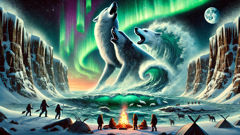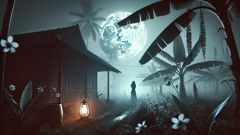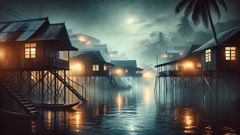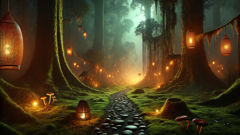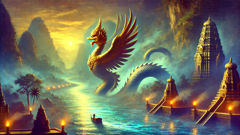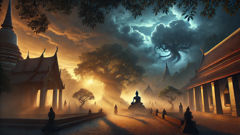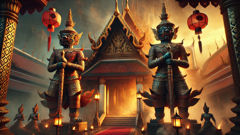Introduction
In the farthest reaches of the Canadian Arctic, where the endless tundra meets the roaring, ice-choked sea, a thousand stories sleep beneath the snow. For countless generations, the Inuit people have gathered in the warmth of their igloos or qarmaqs, their breath mingling with the scent of seal oil lamps, and shared tales as old as the land itself. Some stories warn, some teach, and some speak of things that glide through the shadows between worlds. Among the most mysterious of these is the legend of the Akhlut—a spirit that is neither one thing nor another, but something wild and whole, a guardian as fierce as the winter and as fluid as the tide. According to ancient memory, the Akhlut slips between two forms: in the ocean, it is an orca—sleek, black-and-white, powerful enough to shatter the sea ice; on land, it stalks as a great wolf, with fur as dark as midnight and eyes that glimmer with the wisdom of the deep. To the Inuit, the Akhlut is more than a monster or a myth; it is a living lesson, a reminder that nature is never simple or tame, that what we see is never all there is. It is said the Akhlut appears to those who forget respect, who take more than they need, or who wander too close to the boundary between sea and snow. But sometimes, in rare moments of need or courage, the Akhlut chooses to reveal itself—not as a punishment, but as a teacher. This is the story of one such encounter, passed down through the long polar nights and still spoken when the wind howls like wolves over the ice. It is the story of a young hunter named Nanuq, who faced the Akhlut at the edge of two worlds and found a destiny far greater than any he had dreamed.
Nanuq’s Journey to the Edge
Nanuq was born beneath the eternal sky, in a village so far north that the sun sometimes forgot to rise for days on end. He grew up listening to the pulse of the wind and the whisper of the sea, learning to hunt, to read the tracks of foxes in fresh snow, to know when the ice would bear his weight and when it would swallow him whole. The people of his village depended on what the land gave and feared what it could take. Life in the Arctic was a constant balance—between hunger and plenty, between warmth and cold, between respect and arrogance.
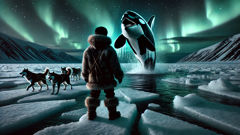
Nanuq’s father was a respected hunter, his mother a healer who knew the secret songs of herbs and spirits. Nanuq himself was restless—quick to laugh, quick to challenge, eager to prove himself on the land. He had heard the stories of the Akhlut since he could remember: how it swam the icy waters, how its footprints sometimes appeared beside holes in the ice where seals vanished without a trace, how its howl could be heard on stormy nights when even the bravest hunters stayed indoors. Nanuq half-believed, half-doubted. The world was already full of enough dangers without inventing new ones, he often said, though he spoke with a bravado meant more for his friends than for his own heart.
It was late in the season when Nanuq’s story began in earnest. The sun dipped low but lingered, casting long shadows over endless fields of white. Seal and caribou were growing scarce, and hunger gnawed at the village. The elders spoke in worried tones, their faces lined with memories of leaner years. Nanuq, driven by a mixture of pride and concern for his family, volunteered to venture farther than any had dared that winter—beyond the safe hunting grounds, past the frozen ridges to the place where the ice met the open sea. His father hesitated, but the need was too great, and Nanuq’s courage too fierce to deny. He set out at dawn with his dogs, his parka heavy with tradition, his heart light with hope and fear in equal measure.
The journey was harsh. Icy winds lashed his cheeks raw, and snow blinded him to all but the shapes of his loyal sled dogs ahead. The world grew silent except for the crunch of runners on packed snow and the distant, ominous groaning of shifting ice. Nanuq navigated by instinct and by the teachings of his elders—by the tilt of stars and the subtle clues in the wind’s song. As he pressed farther, he found old wolf tracks beside the wide, round holes that spoke of recent seal kills—too large for any wolf he had ever seen. Each night he built his shelter and listened to the eerie silence outside, feeling the press of legends all around him.
On the third day, Nanuq reached the edge: a place where snow gave way to a jagged shoreline and the restless sea bucked against the land. The ice cracked and shifted beneath his boots, revealing glimpses of black water swirling below. There were strange marks—prints that began as wolf paws but grew larger and less defined, fading into a smear at the water’s edge. It was here, with his sled dogs restless and the wind howling like distant wolves, that Nanuq first saw the impossible. A shape moved beneath the ice, enormous and dark, gliding effortlessly through the frigid water. Then, with a shattering crash, it broke the surface—a massive orca, its white markings glowing faintly in the dim light. As Nanuq stared in awe and terror, the creature pulled itself onto the ice, its body flowing and twisting until it stood before him—not as a whale, but as a giant wolf with a glistening pelt and eyes as deep and cold as the sea.
Nanuq’s breath caught in his chest. His dogs cowered, whimpering. The Akhlut—there could be no doubt. The spirit’s gaze held him frozen, every instinct screaming to run, to hide, but something ancient and powerful rooted him to the spot. The Akhlut spoke not with words but with presence—a force that filled the world around them. In that silent communion, Nanuq felt a surge of images: the hunt, the hunger, the delicate balance that held all life in its place. He understood then that he had crossed a boundary, not just of land and sea, but of respect—a line invisible but real. He bowed his head, whispering the prayers his mother had taught him. The Akhlut watched, then turned away, vanishing into the night. Nanuq knew his journey was only beginning.
The Trial of Balance
Nanuq returned to his camp with his spirit in turmoil. All night he lay awake, listening to the wind and replaying his encounter with the Akhlut. Its presence lingered—he felt watched, judged, and strangely protected. In the hours before dawn, he recalled the stories his mother had sung: how the Akhlut appeared when the balance between land and sea was threatened, how it punished those who took too much, but sometimes guided those who listened. He wondered what his own actions meant—whether he had trespassed or been chosen.
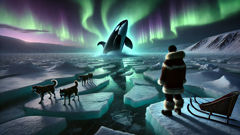
The next morning, the world was transformed. A storm had passed in the night, burying the camp in heavy drifts and sculpting wild shapes from snow and ice. Nanuq dug himself free and checked on his dogs, who remained uneasy. The sea was calm, but a sense of expectation hung in the air. With food supplies dwindling and the village’s need growing desperate, Nanuq decided to try his luck on the edge once more. This time, he moved with a new wariness—a humility learned not from fear but from awe.
He set his traps near fresh breathing holes in the ice and waited, watching seals surface and disappear, their eyes bright and wary. Hours passed, marked only by the slow crawl of clouds and the distant call of gulls. As twilight descended, Nanuq heard a sound unlike any before—a low, echoing howl that seemed to rise from both land and sea. The Akhlut appeared again, this time at a distance, pacing the shoreline. Its wolf form melted seamlessly into the shadows, every movement graceful yet charged with purpose.
Nanuq followed, heart pounding. The spirit led him along the edge of the world—across treacherous ice bridges and over snowfields glittering with frost. The Akhlut paused at places where seals gathered, where fish darted beneath thin ice, where caribou trails converged with fox tracks. Each site showed signs of overhunting or carelessness—bones left unburied, traps set without respect, scars in the land itself. In silence, the Akhlut showed him what was at stake: not just survival, but harmony.
As darkness deepened, Nanuq stumbled and fell through a patch of weak ice. He plunged into freezing water, panic and cold closing around him. For a moment he thought he would drown, lost beneath the weight of his mistake. But a powerful shape surged beneath him—the Akhlut in orca form. It lifted him back to the surface, setting him safely on solid ice. Shivering and exhausted, Nanuq understood. The land and sea were not enemies but partners; to survive, he must honor both. The Akhlut demanded not sacrifice but stewardship—protection for all that lived.
That night, Nanuq built a small fire and offered a portion of his meager food to the spirit. He sang softly, echoing the old songs of gratitude and humility. In his dreams, he saw the Akhlut once more, gliding through water and snow, watching over him with silent approval. When dawn came, Nanuq felt changed—a hunter not just for himself, but for all his people.
Keeper of the Balance
Days passed, marked by subtle shifts in weather and fortune. Nanuq found his traps filled more often, yet he took only what was needed, leaving offerings behind and repairing what he could. He spoke with the land as he worked, whispering thanks to seals and caribou, brushing snow respectfully from old tracks. The presence of the Akhlut never left him—sometimes a shadow flickered on the horizon; sometimes a low howl echoed through the night. Other times, he glimpsed an orca’s dorsal fin slicing through open water just beyond the ice edge. Each sign was a reminder, both of his vow and of his responsibility.
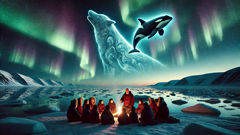
When Nanuq finally returned to his village, he brought not only food but stories. The elders listened in silence as he described his journey and the lessons taught by the Akhlut. Some nodded in understanding, recognizing their own memories in his words; others doubted or feared. But Nanuq’s actions spoke for themselves—he shared his catch generously, taught the younger hunters to respect boundaries, and honored every animal taken. The village flourished through the harshest months, not by abundance alone but by a renewed sense of unity.
One night, as winter began to break and the first hints of spring shimmered on the horizon, Nanuq was awakened by distant cries—panicked shouts from beyond the village edge. He rushed outside and found a group of hunters gathered at the shore. The ice had cracked unexpectedly, trapping several sled dogs and threatening to sweep a child into the sea. Without hesitation, Nanuq dashed onto the unstable ice. As he moved, he felt the old presence—cold, wild, yet protective. A dark shape surged beneath the water; the Akhlut, half-seen, nudged the ice just enough to lift the stranded child to safety.
In the aftermath, the villagers whispered reverently of what they had seen: a massive orca fin breaking the water as a wolf’s howl echoed in the air. Nanuq offered silent thanks to the spirit and led his people in song and gratitude. From that day onward, the legend of the Akhlut became not just a warning but a blessing—a sign that the spirit would watch over those who honored the delicate balance of their world.
Nanuq grew to become an elder himself, passing down not only skills and stories but the lessons of humility and stewardship. The Akhlut’s mark was on him—sometimes seen in his watchful eyes, sometimes heard in the quiet strength of his words. When he walked the shoreline, children would ask if he still saw the Akhlut. He would smile and say, “The Akhlut is always here, wherever land meets sea, wherever we remember to listen.” And so the legend endured, woven into every snowflake and every wave, a promise as enduring as the Arctic itself.
Conclusion
The legend of the Akhlut endures wherever ice meets sea and wolves howl into the night. For the Inuit, its story is more than a warning—it is a guide to living with respect for all life and for the fragile harmony that sustains the world. The Akhlut is a spirit of boundaries and bridges: it reminds us that what seems separate is often joined beneath the surface, that power must be tempered by humility, and that survival in a harsh land depends as much on wisdom as on strength. Nanuq’s tale has become part of the Arctic’s long memory, told and retold to each new generation as winter descends and the wind sings through the white silence. In every story, in every shared meal and careful hunt, the Akhlut’s lesson lives on: nature is not an enemy or a servant, but a partner—a force to be honored and protected. And on certain nights, when the aurora dances and the world feels close to its ancient beginnings, those who listen carefully may still hear the echo of the Akhlut’s howl across the endless snow.

